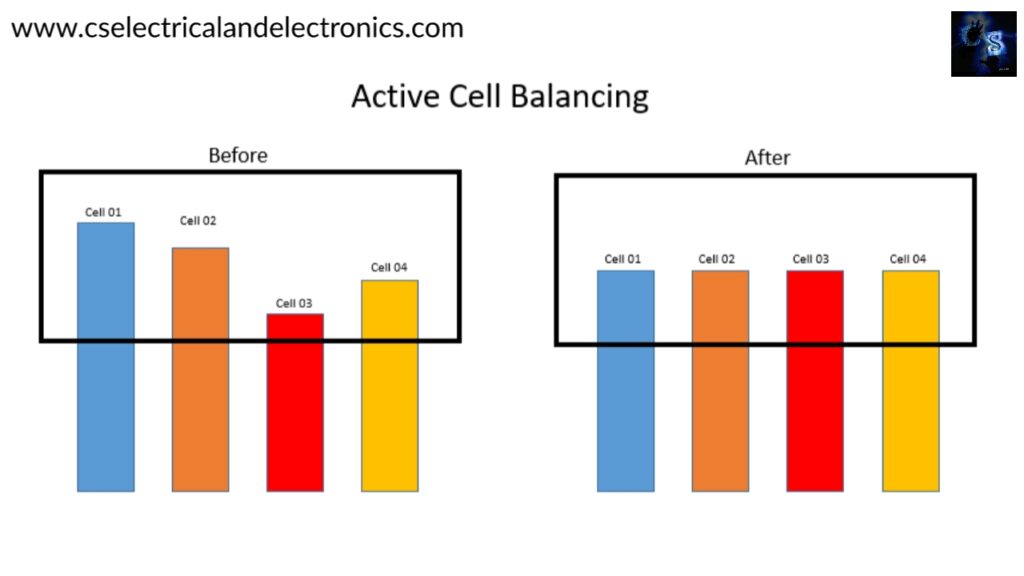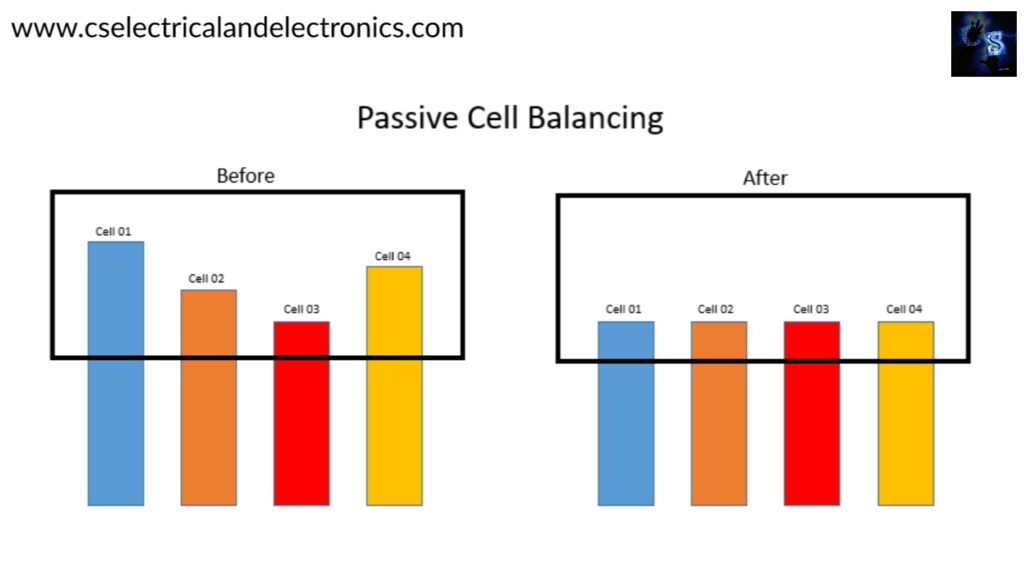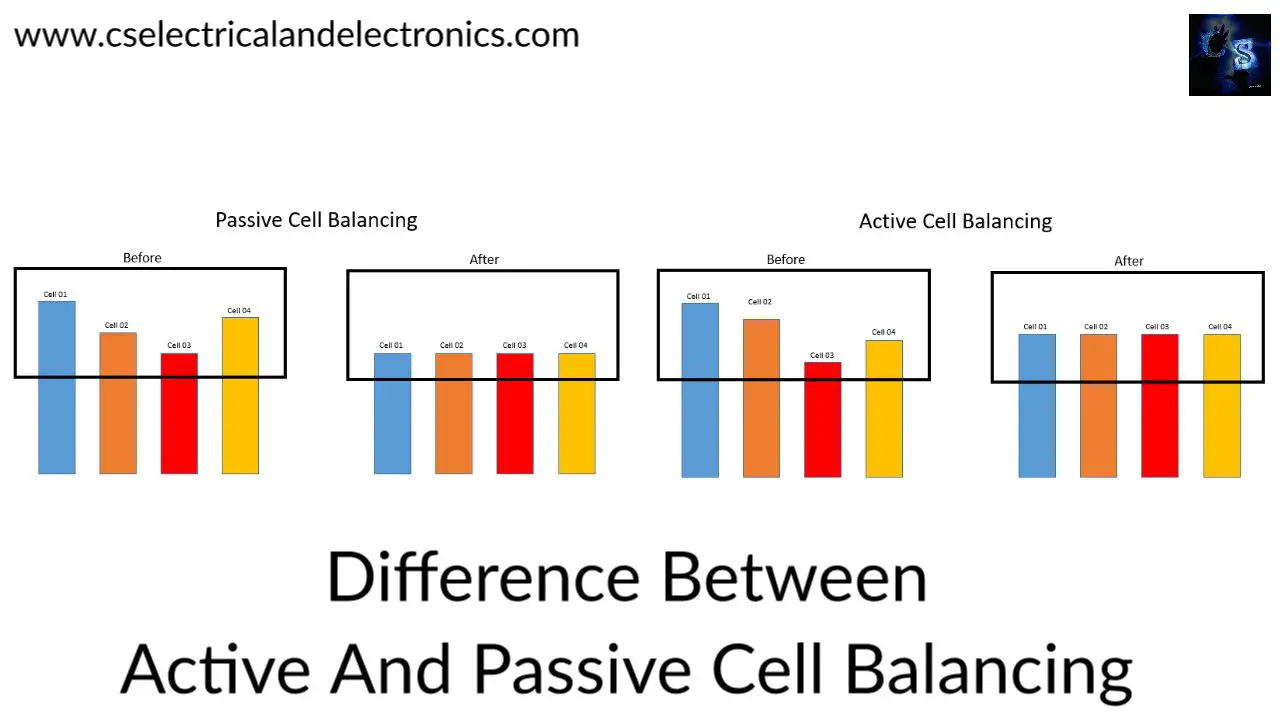What Is Cell Balancing, Difference Between Active And Passive Cell Balancing
Hello guys, welcome back to my blog. In this article, I will discuss what is cell balancing, the difference between active and passive cell balancing, types of active cell_balancing technics and passive cell_balancing technics, applications, etc.
If you have any doubts related to electrical, electronics, and computer science, then ask question. You can also catch me @ Instagram – Chetan Shidling.
Also, read:
- Top 10 MATLAB Projects For Electrical And Electronics Engineers.
- Comparison Between Indoor And Outdoor Substation, Merits And Demerits.
- PWM, Definition, Working, Techniques, Advantages, Disadvantages, Uses.
What Is Cell Balancing
To preserve battery performance over a prolonged service life in a large-format battery system, it is normally required to achieve a charge balancing approach to account for differences in cell performance. An efficient cell_balancing system preserves the desired level of battery production throughout the life of the battery with a proper safety margin, without adding unnecessary cost, weight, or complexity.
Balancing is the process of equalizing the level of charge in lithium-ion cells on a cell-by-cell basis. There are two ways to do cell balancing such as active cell balancing and passive cell balancing.
Now, let’s discuss what is active and passive cell balancing. Active cell_balancing means making the state of charge of each cell equal without dissipating energy through a resistor. Here the energy is transferred from one cell to another cell, from cell to battery pack, or from battery pack to cell. Passive cell_balancing means making the state of charge of each cell equal by dissipating energy through a resistor.

In case of active equalizing method, the state of charge of each cell will become equal to the average state of charge of all cells. Here the energy of cell 01 and 02 will be transferred to cell 03 and 04.

In case of passive equalizing method, the state of charge of each cell will be equal to the state of charge of cell 03 because it has low SOC. The energy present in cell 01, 02, and 04 will be wasted or dissipated through a resistor to make each cell SOC equal.
Types Of Active And Passive Cell Balancing Methods
01. Passive Balancing:
- Fixed shunting resistor
- Switching shunting resistor
The primary advantage of any of these types of passive balancing is the simplicity (and hence, lower cost) of the circuitry involved, compared with active balancing designs. The drawbacks are: Energy is wasted as heat, which could be otherwise used productively, Heat is generated. For fast balancing, more heat is generated, and Battery pack life could be shorter with respect to a pack with an active balancing design.
02. Active Balancing:
a. With capacitor:
- Single capacitor
- Multiple capacitors
b. With inductor or transformer:
- Single / Multiple inductors
- Single transformer
- Multiple transformer
c. With DC-DC converter
- Flyback / Forward converter
- Full-bridge converter
An active cell_balancing circuit normally uses energy transferring elements such as inductors, capacitors, or transformers to balance cell energy in the battery pack. This active cell_balancing circuit has a lower cell balancing time and has greater efficiency than the passive cell_balancing circuit. However, this cell equalizing circuit has a huge cost and needs complex system control algorithms for balancing cells.
Difference Between Active And Passive Cell_Balancing
| SI.No | Active | Passive |
| 01. | Energy is not dissipated or wasted | Energy is dissipated or wasted |
| 02. | Energy is transferred from one cell to another cell or from battery pack to cell or from cell to the battery pack | The energy of a cell that has a high state of charge is transferred to a resistor |
| 03. | Bulky in size | Small size |
| 04. | High cost | Low cost |
| 05. | High efficient | Low efficient |
| 06. | Fast balancing | Slow balancing |
| 07. | Good thermal management | Poor thermal management |
| 08. | Applications: Used in UPS (Uninterrupted power supply), ESS (Energy storage system), EV/HEV (Electrical vehicle). | Applications: Used in a portable device, low-power system |
I hope this article may help you all a lot. Thank you for reading. We will also do freelancing work, if you have any work, please feel free to contact us through the mail.
Also, read:
- 10 Tips To Maintain Battery For Long Life, Battery Maintainance
- 10 Tips To Save Electricity Bills, Save Money By Saving Electricity
- 100 (AI) Artificial Intelligence Applications In The Automotive Industry
- 100 + Electrical Engineering Projects For Students, Engineers
- 1000+ Control System Quiz, Top MCQ On Control System
- 1000+ Electrical Machines Quiz, Top MCQs On Electrical Machines
- 1000+ MATLAB Simulink Projects For MTech, Engineering Students
- 2024 Is About To End, Let’s Recall Electric Vehicles Launched In 2024

